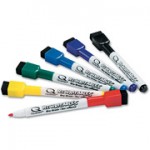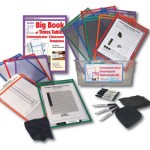The Secret of Speed Tests, Part I gave an overview of how I conducted the weekly (or near-weekly) “Mad Minute!” speed drill (not speed tests!). I did the Mad Minute every Friday as an opening activity/activating exercise, even if we were to have a quiz or test, and as I mentioned, the results were really amazing. This post will discuss the setup, processes, and student training used to conduct the Mad Minute activity.
As with anything done in the classroom, the preparation, organization, and training will make this process much easier on you, and more enjoyable for everyone.
Pre-Setup
Each student had “Class Folder” that stayed in the room, color-coded by period. In this folder, students kept class rules, worksheets, and other classroom handouts. They also kept their Mad Minute graph (see the previous post), so this sheet never got ‘lost’ or destroyed. These were simple two-pocket folders, and I got them for a few cents each at the back-to-school sales.
On the tables were cheap dry-erase markers, a small eraser for the markers, and the Mad Minute sheets in protectors (that the students could directly write on/erase off). Hint: Have PLENTY of dry erase markers handy! WalMart had a nice little set of cheap markers that had erasers on the ends.
I had 5 separate Mad Minutes sheets (easiest being ‘A’, the most difficulty being ‘E’) with problems on one side and the answers completely worked out on the reverse side. A single set of the Mad Minute Sheets where in a ‘Classroom Communicator‘ sheet protector.
Classroom Setup:
- Agenda on the board listed the days’ Mad Minute Sheet (A-E)
- Each table had a pair of dry-erase markers and erasers
- Each table had the Classroom Communicator Sheet protectors with the drill sheets
- Student leaders passed out Class Folders to each student (before class begins)
Training Points:
Train your KIDS! Once they know the process, this opening activity will be much easier to implement and go quickly and easily.
When your students enter the classroom, they are to:
- Get the correct Mad Minute sheet in the Classroom Communicator sheet protector
- Get a marker ready to use. Make sure it works! (Vital for your sanity…)
- Tell the teacher immediately if your marker does not work.
When Mad Minute is complete:
- Self-grade their test by counting each correct digit (including partial sums in standard multiplication)
- Update their graphs
- Erase their work on their sheet protector
- Put away the marker, eraser, and sheet protector/Mad Minute sheet (kept at the end of their table).
- Sit silently until everyone else is finished
In Part 3, I will go into more detail about the self-grading and updating of the graphs.
Attitude (That is, YOUR attitude!)
So much of what I wanted for my students was just to be better at math and enjoy ‘doing’ math. As I have mentioned many times, math fluency is so important for their future achievement.
- (You!) Be excited about the Mad Minute. Hey, your kids are going to get faster and better at adding and multiplying (or whatever you are drilling)! I would say something like, “I love mad minute, I can see you getting better each time we do this”. I know that not every one of your students will enjoy the Mad Minute. But their attitude is dependent on your attitude!
- Privately celebrate small successes with a student– “Hey, your point jumped up this week, Awesome!” or “Look at the trend of your points increasing. Wow, you’re getting fast!”
- Have fun! It is OK to be a little silly at times. On the smart-board, I had large countdown timer that had a big red ‘start’ button. The kids would be so keyed up and ready to speed through as fast as they can, sometimes I would ‘keep them in suspense’:
“Ok, everyone ready for Mad Minute?”
“Yes, Mr. Esterman…”
“Heerrree we go… Ready… Set…. Oh yeah, don’t forget to update your graphs at the end…”
“We know!!!”
“Ready… Set… Everyone’s marker working!??!”
“AAAAHHHH!!!! Mr. Esterman!! Stop it!!”
“Ok, ok…Ready. Set. Go!”
The first time my class (usually during the first full week of school) would do a Mad Minute, teaching through the process took almost the whole class time. I explain each step, students create their graphs, we practice the routine, etc. However, taking that extra time for one period out of the whole school year, I believe, is invaluable! Because after 1 or 2 times of Mad Minute!, the whole activity can be completed in 7-10 minutes.



